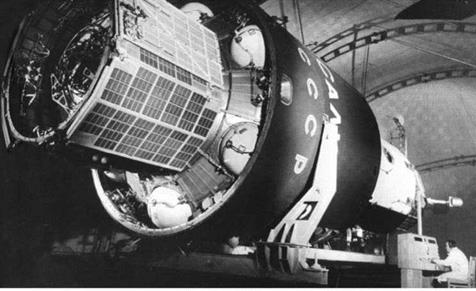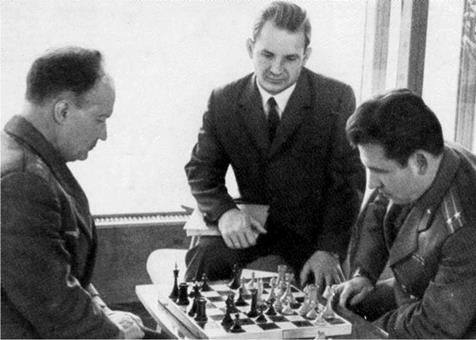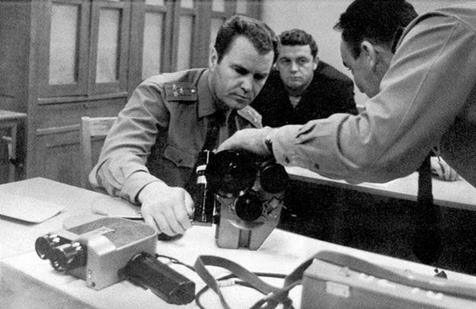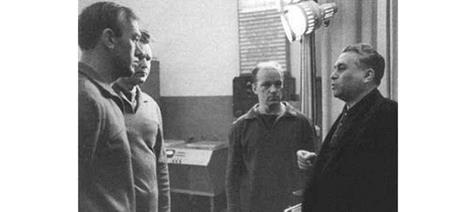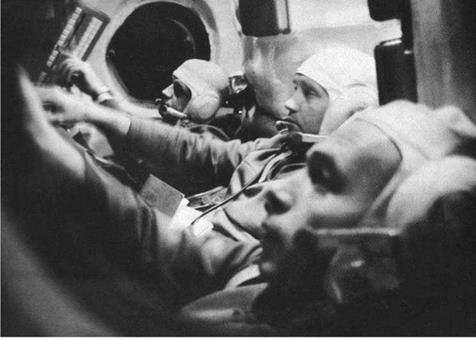THE DISMISSAL OF SHONIN
When the DOS programme started in early 1970, it was only one of several manned space projects. In addition to the 12 cosmonauts assigned to the DOS crews there was a group of ten cosmonauts in training at the TsPK for projects involving other versions of the Soyuz. Pavel Popovich led the 20 military cosmonauts in the Almaz group. Valeriy Bykovskiy led the now much reduced lunar group. There was also a team in training for the Spirala ‘rocket plane’ project. Because the facilities were in constant use, some of the simulators were in need of significant maintenance. The mockup of the DOS-1 station was not able to be installed at the TSPK until October 1970, barely four months before (on the target schedule) the first crew were due to be launched.
Having worked 24 hours a day, the Khrunichev factory managed to deliver three stations to the TsKBEM in December 1970 for testing.
The Ministry of General Machine Building formed the DOS-1 State Commission, drawing its members from the leading people responsible for the design and testing of the spacecraft, training the cosmonauts, launch preparations, mission control and recovery activities. By tradition, at the final meeting of a State Commission prior to a launch, representatives from the TsKBEM, the Baykonur cosmodrome and all the other institutions which participated in the preparation of the mission would assess their readiness. After the decision of the date and time of launch, Kamanin would present the prime and backup crews. Since 1966 the State Commissions for Soyuz flights had been chaired by Major-General Kerim Kerimov, one of the Ministry of General Machine Building’s directorate chiefs. He had previously been responsible for developing and operating the facilities of the Strategic Rocket Forces. At the inaugural meeting of the new State Commission in late December 1970, the Chief Designers reported on the status of the programme, and the progress in constructing the two stations and the 7K-T ferries for the Soyuz 10 and Soyuz 11 missions. As a result of problems testing its subsystems, it would not be possible to launch DOS-1 in February as hoped, and its launch was rescheduled for 15 March 1971. There was an argument about the duration of the first missions. Mishin and the medical experts of the Institute for Biomedical Problems (IBMP) in Tushino, which was the most prestigious of the civilian space medicine institutions, wanted the first crew to make a 30-day flight, but Kamanin and the physicians of the Central Air Force Scientific Research Hospital (TsVNIAG) argued for a maximum target of 25 days; the issue was left unresolved.
|
The DOS-1 station undergoing final system tests. |
Shortly after the meeting, General Kutakhov, the Commander in Chief of the Air Force, visited the TsKBEM to inspect progress with the first station. Mishin tried to convince him to overrule Kamanin and support a 30-day flight for the first mission, but Kutakhov diplomatically replied that the matter should be decided by aerospace physicians and those who were responsible for training the cosmonauts. Although Mishin inferred from this that Kutakhov supported Kamanin, this was not the case. Aware that his days were numbered, Kamanin wrote to Kutakhov proposing to retire in favour of his aide, Major-General Leonid Goreglyad. But Kutakhov had his own candidate, a man who had worked under his command many years ago – cosmonaut Vladimir Shatalov. Kamanin thought that the more experienced Goreglyad would be a better choice, at least until Shatalov had matured as a manager.
In general the crew training was efficient, and the cosmonauts divided their time between the facilities in Zvyozdniy and Kaliningrad as necessary. One of the most important military experiments, which was to be done by both of the DOS-1 crews, was to monitor the launch of intercontinental ballistic missiles. In the early days of February 1971, Shonin’s and Leonov’s crews went to Baykonur for special training. Flying in a Tu-104 aircraft, they observed night launches of ballistic missiles using the Svinetz (‘Lead’) apparatus which was to be installed on the station. However, on 5 February, soon after their return, Shonin missed a session of important quality control and testing (KIS) training in Kaliningrad, apparently because he was drunk. A furious Mishin called Kamanin and loudly announced his firm decision: ‘‘He’ll never fly again in my spaceships!’’ Kamanin called Shonin, and promptly realised how stupid Shonin had been. Kamanin had received reports of Shonin’s drinking habits in March 1970 but, having been impressed by Shonin on the Soyuz 6 mission,
|
Kubasov observes Shonin (right) and Kamanin (left) playing chess. |
had taken no action. Now Kamanin realised that for months the TsPK managers had been covering for a drunken cosmonaut. This left Kamanin with no option. Shonin pleaded his case: “Take my Hero’s star, strip me of my colonel’s rank, but please don’t take my spaceflight from me!’’ Shonin had received the Gold Star of Hero of the Soviet Union for his space flight, and it was the highest honour the nation could award a military officer. Leonov, who served as one of the deputies to Kuznyetsov, the head of the TsPK, approached Kamanin in an attempt to defend Shonin, but it was too late.[28]
Kamanin now suggested the strongest military cosmonaut, Shatalov, to command the first crew. Although this reinstated the crew nominated by the TsKBEM in May 1970, Mishin was against the idea. He sought to exploit Shonin’s dismissal to call for assigning an all-civilian crew to the first DOS-1 mission: Yeliseyev would be in command, with Kubasov as flight engineer and Rukavishnikov as research engineer. Of course, Kamanin rejected this. After much argument, Mishin was obliged to accept Shatalov as the commander of the first crew. Dobrovolskiy took Shatalov’s place on the third crew, and Lieutenant-Colonel Aleksey Gubaryev, a rookie from the second group of military cosmonauts, was given command of the fourth crew. In this reshuffle, only Leonov’s crew remained untouched.
|
|
Shatalov (foreground) and Volkov training with photo-equipment.
|
|
After Shonin’s dismissal, Shatalov (second from the left) joined the ‘first crew’ with 2 months remaining to the launch of the DOS-1 station. Here he, Yeliseyev (left) and Rukavishnikov listen to Deputy Chief Designer Yakov Tregub, the head of manned flight control. (From the book Life – A Drop in the Sea, courtesy astronaut. ru)
On 12 February 1971, with the launch of the first space station imminent, the crews were changed for the third time:
• Crew 1: Vladimir Shatalov, Aleksey Yeliseyev and Nikolay Rukavishnikov
• Crew 2: Aleksey Leonov, Valeriy Kubasov and Pyotr Kolodin
• Crew 3: Georgiy Dobrovolskiy, Vladislav Volkov and Viktor Patsayev
• Crew 4: Aleksey Gubaryev, Vitaliy Sevastyanov and Anatoliy Voronov
However, as events transpired, this plan did not last.
|
The ‘first crew’ for DOS-1: Yeliseyev, Shatalov and Rukavishnikov (foreground) in the Soyuz simulator. |
Specific references
1. Kamanin, N. P., Hidden Space, Book 4. Novosti kosmonavtiki, 2001, pp. 153— 160 and 260—262 (in Russian).
2. Yeliseyev, A. S., Life – A Drop in the Sea. ID Aviatsiya and kosmonavtika, Moscow, 1998, pp. 70—72 (in Russian).
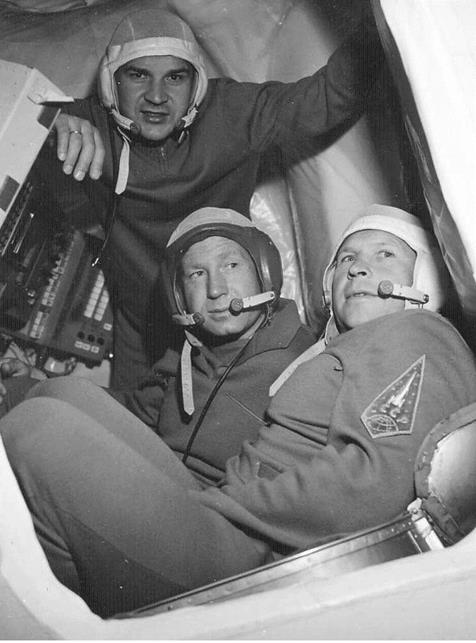
|
|
The ‘third crew’ for DOS-1: Volkov (rear), Dobrovolskiy and Patsayev. |
|
The ‘fourth crew’ for DOS-1: Gubaryev (left), Voronov and Sevastyanov. |

DOS cosmonauts. Sitting: Leonov (left), Yeliseyev, Shatalov, Rukavishnikov and Kubasov. Standing: Kolodin (left), Dobrovolskiy, Volkov and Patsayev. (From the private collection of Rex Hall)











